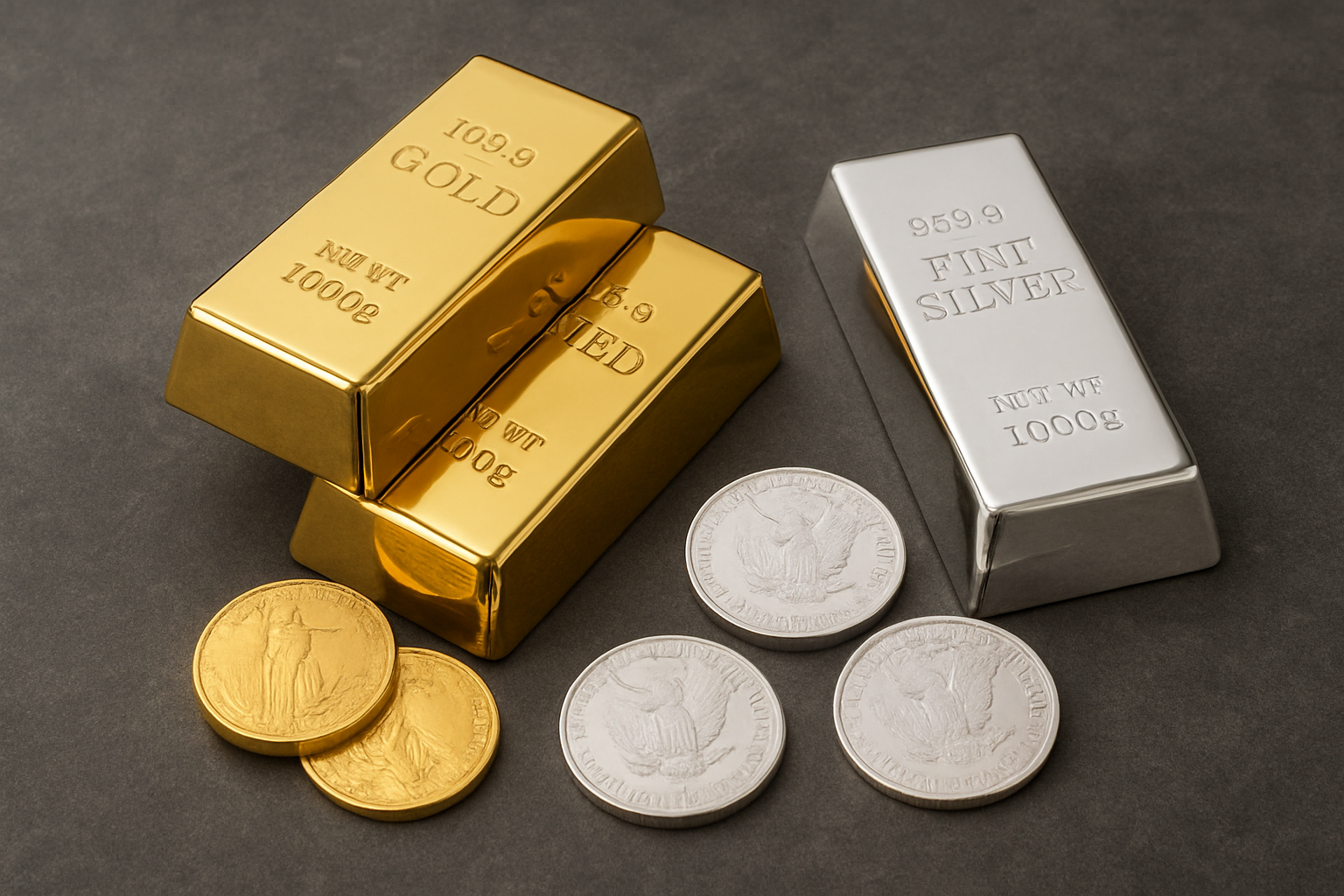Introduction
Gold and silver markets witnessed a significant pause on November 3 2025 as both metals saw a decline in prices after several weeks of strong upward momentum. In India the price of 24 carat gold stood at around ₹122990 per 10 grams while 22 carat gold hovered near ₹112740 and 18 carat gold traded around ₹92240. Silver prices too moved lower after festive season highs with 1 kilogram priced around ₹151900 in key cities such as Mumbai and Delhi.
Despite this pullback analysts suggest that the move reflects a temporary correction rather than a reversal of the broader bullish trend. The fundamentals for precious metals remain intact supported by the central bank buying inflationary concerns and long term safe haven demand.
Global Price Movement And Domestic Trends
Globally spot gold slipped to around 3984 dollars per ounce showing a daily decline of about half a percent after dropping nearly three percent the previous week. Silver also fell as traders booked profits following its strong October rally.
In India gold rates showed mild regional variation but moved largely in tandem across major cities. In Delhi the price for 24 carat gold was approximately ₹12314 per gram while in Mumbai and Kolkata it traded near ₹12299 per gram. Chennai saw slightly higher levels at ₹12337 per gram due to regional premiums and transport costs.
For silver domestic rates averaged about ₹151900 per kilogram though Chennai and Hyderabad quoted marginally higher prices at around ₹165900 per kilogram. The difference reflects local demand and supply conditions as well as refining and logistics margins.
The data highlights that while the market has softened from its peaks, the overall price structure remains historically high indicating continued investor interest and tight supply.
Factors Driving The Correction
Easing Safe Haven Demand
The sharp rise in bullion prices during the previous quarter was largely driven by safe haven demand amid global geopolitical tensions and persistent inflationary pressures. As some of these fears eased in late October risk appetite in global markets improved leading to reduced buying interest in gold and silver. The optimism over global trade talks and improved market sentiment caused investors to move back into risk assets such as equities.
Technical Profit Taking
Gold prices had surged rapidly from around 3800 dollars to nearly 4400 dollars per ounce within a short period creating overbought conditions. As the rally extended traders chose to book profits which triggered a wave of selling. This technical correction is typical in strong bull markets where prices need to consolidate before resuming their upward journey.
Softening Festival Demand in India
In India the festive and wedding seasons typically mark a peak in gold consumption. Leading up to Dhanteras and Diwali, domestic demand had already driven prices to record highs. With the festive phase now ending, immediate retail demand has cooled creating short term downward pressure. However jewellers expect activity to revive during the winter wedding season starting mid November.
Currency and Import Cost Influence
The rupee has remained relatively stable against the dollar in recent weeks which has helped moderate the impact of global price movements on domestic bullion rates. In addition a temporary easing in import demand by large traders has reduced near term upward pressure on prices.
City Wise Gold And Silver Rate Overview
Northern and Western India
Delhi and Mumbai continue to serve as benchmarks for bullion prices in the north and west of India. Gold traded around ₹12299 to ₹12314 per gram for 24 carat purity while silver remained close to ₹151900 per kilogram. The narrow price gap between these metros indicates efficient market integration and consistent supply.
Southern India
Chennai Hyderabad and Bengaluru recorded slightly higher gold prices around ₹12337 per gram for 24 carat gold. These regions often see stronger jewellery demand and slightly higher making charges during festive periods. Silver rates here hovered near ₹165900 per kilogram reflecting high craftsmanship premiums and consumer demand for silver ornaments.
Eastern and Smaller Cities
Kolkata and Bhubaneswar followed similar pricing patterns to Mumbai with gold around ₹12299 per gram. In smaller markets such as Jaipur Surat and Lucknow prices were marginally higher due to logistics and lower liquidity in wholesale bullion supply.
Overall the narrow range of differences among Indian cities shows how gold pricing has become increasingly standardised driven by digital trading platforms and real time market linkages.
Why The Long Term Outlook Remains Strong?
Even though the short term trend points to correction, the fundamental drivers for gold and silver remain intact. Global central banks continue to accumulate gold as part of their reserve diversification strategies which provides consistent demand at institutional levels. Inflationary concerns in major economies also continue to boost the appeal of precious metals as a hedge against currency depreciation.
Real interest rates remain low or negative in several developed economies making non yielding assets like gold relatively attractive. The steady accumulation by exchange traded funds and retail investors across Asia adds another layer of long term support.
In India gold retains its traditional role as a store of value and an integral part of household savings. With volatility in equity markets and uncertain returns in real estate many investors continue to rely on gold for portfolio stability. Silver also benefits from growing industrial applications especially in electronics and renewable energy sectors which enhance its long term investment potential.
Impact On Different Stakeholders
For Retail Buyers
The ongoing correction can be seen as a buying opportunity for individuals planning jewellery purchases or small investments. Prices remain high compared to long term averages but the dip provides better entry levels than those seen during the festival peak. Buyers should ensure proper hallmark certification and compare making charges across jewellers before finalising purchases.
For Investors
Investors holding gold through exchange traded funds or sovereign gold bonds may consider rebalancing portfolios. Those with limited exposure to bullion can use the current weakness to accumulate gradually rather than chasing short term momentum. Diversification remains key as gold should ideally make up between 5 and 15 percent of an investment portfolio depending on risk appetite.
For Jewellers and Dealers
The decline in wholesale prices brings temporary relief for jewellers who faced high inventory costs during the festival period. However retail demand has softened and competition among dealers may increase. Jewellers will likely focus on promoting lightweight designs and investment grade products to sustain sales volumes.
For Policymakers and Economists
A moderate correction in gold prices can help ease India’s import bill, supporting currency stability and trade balance. Policymakers generally prefer stable gold prices since sharp surges can strain foreign exchange reserves.
Key Risks And What To Watch Ahead?
Several variables will determine whether gold and silver resume their upward momentum or continue to consolidate through November. A resurgence in geopolitical tensions or renewed inflation pressure could reignite safe haven demand. Conversely, a strong US dollar or a decisive shift towards higher global interest rates could keep bullion under pressure.
In the domestic context, upcoming wedding demand, changes in import duties, and rupee movement against the dollar will shape short term price direction. If the rupee weakens or if import restrictions tighten, domestic gold prices could rise even if international prices stay flat.
For silver, industrial demand trends will remain crucial. Any supply disruptions or increased use in clean energy technologies could quickly lift prices again.
Strategic Takeaways For Consumers And Investors
The current phase should be seen as a healthy correction after months of strong gains.
- Buyers can take advantage of moderate prices but should avoid speculative short term trades.
- Long term investors can continue systematic accumulation through digital gold, ETFs, or sovereign bonds rather than lump sum purchases.
- Monitoring currency movement, inflation data, and global monetary policy will help anticipate future price swings.
- For jewellery buyers this is a favourable window before potential winter wedding season price upticks.
Conclusion
The decline in gold and silver prices on November 3 2025 marks a period of consolidation in an otherwise strong year for precious metals. Gold remains up more than fifty percent year to date even after the correction reflecting continued investor confidence in bullion as a reliable store of value. Silver too has corrected from its highs but retains long term potential given industrial demand growth.
For Indian households and investors, the message is clear: the current dip offers an opportunity to re-enter or rebalance exposure without fear of a structural downturn. The long term trajectory remains upward, supported by inflationary pressures, central bank accumulation, and sustained cultural affinity toward precious metals in India.


